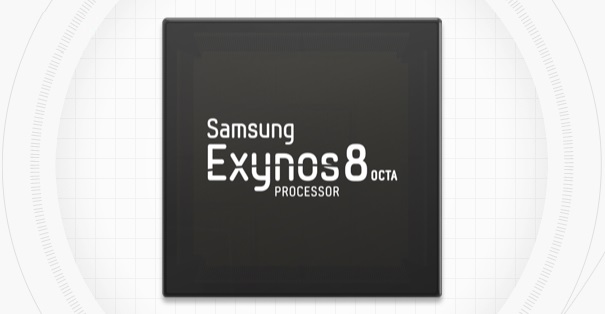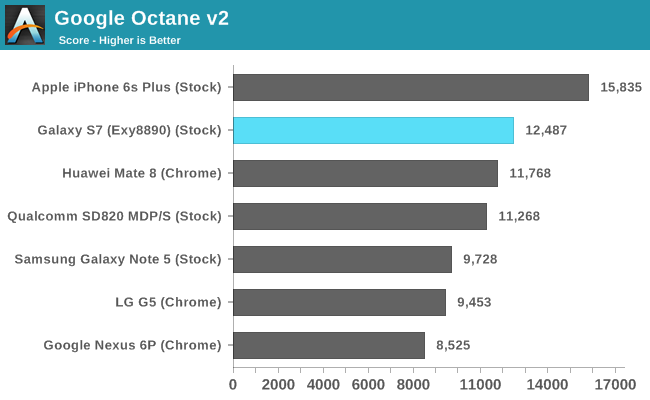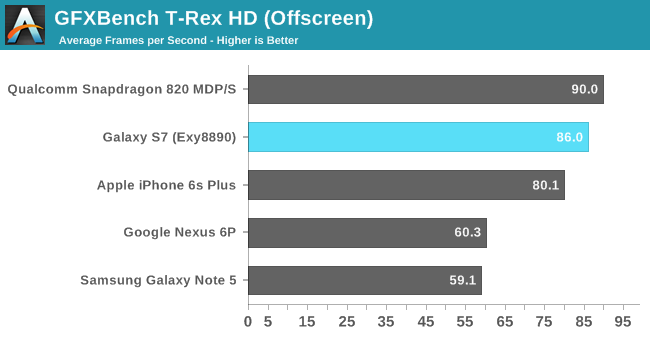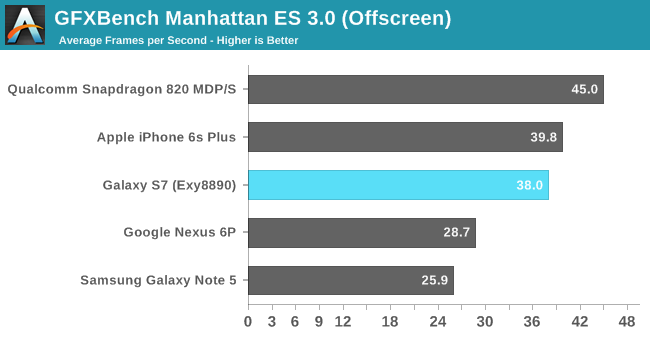Early Exynos 8890 Impressions And Full Specifications
by Andrei Frumusanu on February 21, 2016 6:15 PM EST- Posted in
- Smartphones
- Mobile
- SoCs
- Exynos 8890
- Exynos M1
- Samsung Galaxy S7

| High-End SoCs Specifications | |||
| SoC | Snapdragon 820 | Exynos 8890 | Exynos 7420 |
| CPU | 2x Kryo@1.593GHz 2x Kryo@2.150GHz |
4x A53@1.586GHz 4x Exynos M1 @ 2.60GHz (1-2 core load) 2.29GHz (3-4 core load) |
4x A53@1.50GHz 4x A57@2.1GHz |
| Memory Controller |
2x 32-bit LPDDR4 @ 1803MHz 28.8GB/s b/w |
2x 32-bit LPDDR4 @ 1794MHz 28.7GB/s b/w |
2x 32-bit LPDDR4 @ 1555MHz 24.8GB/s b/w |
| GPU | Adreno 530 @ 624MHz |
Mali T880MP12 @ 650MHz |
Mali T770MP8 @ 770MHz |
| Mfc. Process |
Samsung 14nm LPP |
Samsung 14nm LPP |
Samsung 14nm LPE |
The Exynos 8890 employs Samsung's own designed Exynos M1 cores. The micro-architecture at a high level resembles ARM's big cores, but Samsung seems to have made quite a few changes and improvements when compared to ARM's designs. While by now I do have a quite good idea of what the Exynos M1 looks like, we'll be covering the topic more in-depth in a future article once we'll be able to gain better insight from our own unit for proper benchmarking and power measurements.
On the CPU side we find an 8-core SoC composed of 4x Cortex A53 cores running at up to 1.586GHz coupled with 4x Exynos M1 cores in a big.LITTLE configuration. The most surprising revelation was the fact that the M1 cores reach an extremely high clock of up to 2.6GHz. This represents quite a significant boost over some past rumors which had put expectations 2.3-2.4GHz maximum frequency range. The catch here is that the Galaxy S7's power management doesn't allow all four cores to run at this high frequency but rather only enables the maximum clock when there's at most 2 cores loaded. If there are 3 or more cores under high load, the CPU frequency doesn't surpass 2288MHz.
On the GPU side we knew that we'd encounter a new ARM Mali T880MP12 - the currently largest Mali implementation available among existing SoCs. Back in November I theorized that Samsung would use the larger core implementation to lower the clocks of the GPU block and thus achieve better power efficiency. Indeed that's what seems to have happened as the Exynos 8890's GPU peaks at 650MHz versus the 770MHz frequency for the Exynos 7420. Hopefully this means that the new SoC will be able to maintain its peak performance for longer periods of time.


While I didn't have the time to run too many benchmarks, I did manage to run a few of our basic browser tests as well as GFXBench. We haven't had the opportunity to benchmark the Snapdragon 820 Galaxy S7 yet, therefore I included the score numbers of the MDP/S platform to represent a best-case scenario for the Snapdragon 820 until we can get apples-to-apples scores based on Samsung's browser. This still mostly due to the fact that Chrome is seemingly not yet optimized to take advantage of Kryo's new architecture, and as a result scores some rather mediocre numbers, as seen in some preliminary LG G5 numbers included in the graphs above.


Some quick GPU benchmarks also put the Exynos 8890 slightly behind the Snapdragon 820 in the MDP/S. We will still have to see if actual Snapdragon 820 devices are able to deliver the same performance as the MDP/S platform as there might be some thermal limitations coming into play. Again, we can't comment too much on the scores before we get to know each device's long-term performance and if the attained numbers are sustainable for long periods of time.
One observation I made today which was particularly concerning, was that both with the Snapdragon 820 LG G5 as well as the Exynos 8890 Galaxy S7 got considerably warm after running some heavy workloads. The fact that the Galaxy S7 touts having a heat-pipe thermal dissipation system is a quite worrying characteristic of the phone and should in no way be seen as a positive feature as it points to high power draw figures on the part of the SoC.
The first impression is that the performance difference between the Snapdragon 820 and the Exynos 8890 doesn't seem to be very large, therefore it will be the SoC's power draws and power efficiencies which will determine if, and which one of both will represent a superior design. Hopefully in the coming weeks and months we'll be able to get a better understanding of this new generation of SoCs so that we can paint a definitive picture of the current status of the mobile SoC space.










94 Comments
View All Comments
SydneyBlue120d - Monday, February 22, 2016 - link
Is unlimited HEVC encoding with both IOS and HDR at 2160p60 supported? Thanks a lot.alamilla - Monday, February 22, 2016 - link
I think I've stumbled into the WCCFTech comment sectionjann5s - Monday, February 22, 2016 - link
I don't understand why samsung would build an SD820 and an Exynos8890 version, can somebody explain?However, it will provide a nice comparison platform
Kvaern2 - Monday, February 22, 2016 - link
If I'm not mistaken then it's because they they lack the IP rights to build their own modem for the US market and they are pretty much forced to use Qualcomm's CPU if they want a Qualcomm modem due to Qualcomms pricing scheme.extide - Monday, February 22, 2016 - link
Nope, the Galaxy S6 lines and the Note 5 all used a complete Samsung Chipset, the 7420 AP, plus the Shannon 333 modem.I mean, the Qualcomm modem is better, but yeah, I agree with the OP, I don;t see why they really do this, unless they are just trying to remain friendly with Qualcomm...?
N Zaljov - Monday, February 22, 2016 - link
If I remember correctly, the CDMA models of the S6 and Note 5 are using an MDM9x35 modem.extide - Monday, February 22, 2016 - link
Boy, sure is a bit disappointing that we will not see the 8890 in the US. Not that I have anything against the 820, but there are plenty of other phones that will be available with it, but I doubt we will see thee 8890 in anything :(.I really think Qualcomm should have gone with more cores. Either go with 6 Kry cores, or put some A53 or even A35's in there. As it stands, it really falls behind in MP performance, which actually does matter to some degree.
Avidanyum - Monday, February 22, 2016 - link
Problem no roms for exyons no cyanogenmod for you!cynic783 - Monday, February 22, 2016 - link
Checkmate Crapple! Android so much faster its not even funny now.CrazyElf - Tuesday, February 23, 2016 - link
The bottom line seems to be that the Apple chips are vastly superior (we're talking a generation, maybe more) ahead in single threaded CPU performance.This is something that Android SOC designers need to work on - big time. We're talking a gap on the order of 2580-30% here, and when the A10 comes out, it will probably be something on the order of 50-75%.
There is also the fact that Apple's chips probably run cooler too - I'd love to see a performance per watt in single threaded comparison. It won't be pretty for Android I bet. (Oh and just so you know, I'm far from an Apple fan).
We need more information here, but between the Exynos 8890 and the Snapdragon 820, I'd rather have the 820.
- It is looking (from the limited info we have) like the 820 has a stronger GPU
- Exynos means zero chance of custom ROMs based on AOSP
Although there is some OS scheduling, I don't think that all 4 cores can be used effectively right now.
Again too early to tell and we need to see if either chip throttles in real life.